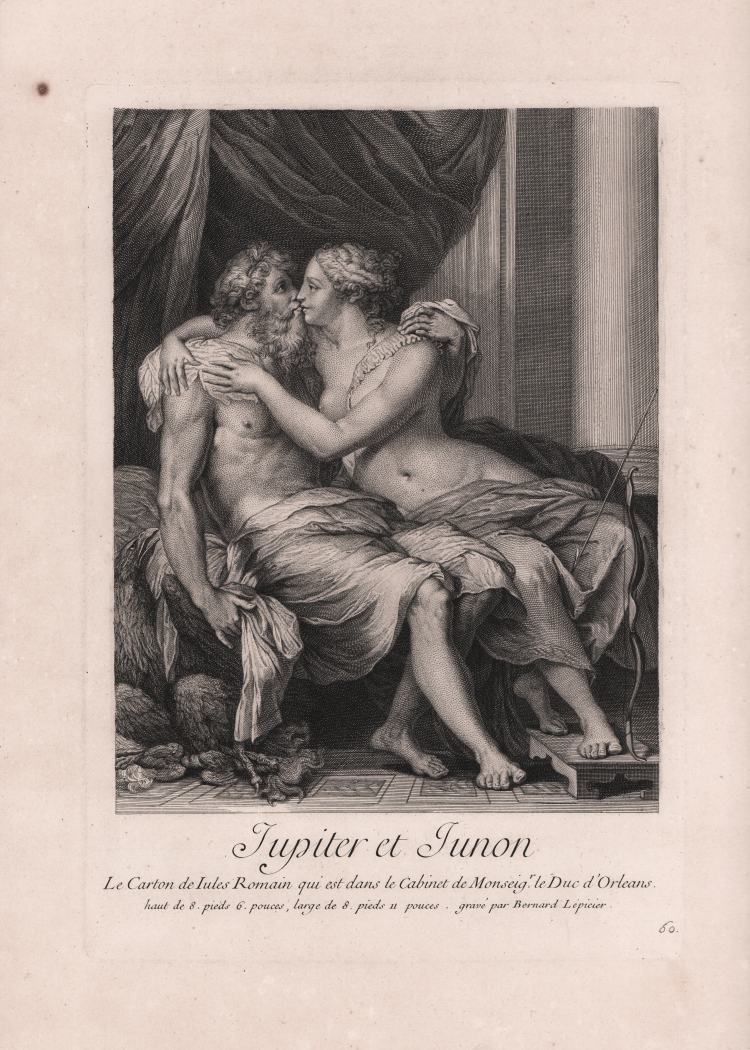



| Reference: | s31270 |
| Author | Bernard Lépicié |
| Year: | 1729 ca. |
| Measures: | 231 x 335 mm |


| Reference: | s31270 |
| Author | Bernard Lépicié |
| Year: | 1729 ca. |
| Measures: | 231 x 335 mm |
Etching and engraving, c. 1729/40, on contemporary laid paper. In perfect condition.
Engraved by Bernard Lépicié, after the cartoon by Perino del Vaga for the tapestries of the Loves of Jupiter, formerly attribued to Giulio Romano.
The cartoons of the 'Loves of Jupiter' were first recognised as being Perino's documented designs of c.1531/2 for the tapestries in the salone dei Giganti in the Palazzo Doria in Genoa by Davidson in 1988.
The plate is from the series "Recueil d'estampes d'après les plus beaux tableaux et d'après les plus beaux desseins qui sont en France".
Also known as 'Recueil Crozat', is a series of plates commissioned by the collector Pierre Crozat and reproducing famous paintings and drawings of the era; 140 plates were published in 1729. A second volume formed by 42 prints (instead of the 110 plates initially planned) was issued in 1740.
After Crozat's death, the plates were sold to a company of booksellers who commissioned Mariette to reorganize the 'Recueil'; Mariette divided the plates into two volumes, added some missing descriptions, and advertised the set to the public in 1742.
In 1764, Basan bought the plates and the text, and republished the 'Recueil', but replaced the woodcuts by intaglio prints. Basan also published the 45 plates reproducing the Italian paintings from the collection of the Duc d'Orléans in a volume entitled 'Recueil d'après la gallerie du palais royal'
Bernard Lépicié (Parigi 1698 - ivi 1755)
|
Engraver, part of a French family of artists. François-Bernard Lépicié was an engraver who became secretary and historiographer of the Académie Royale de Peinture et de Sculpture, in which capacity he compiled a catalogue of the paintings in the French royal collection and an important set of lives of the Premiers Peintres du Roi. His wife, Renée-Elisabeth Lépicié (née Marlie; 1714-73), was also an engraver, signing a number of plates after François Boucher, Jean-Siméon Chardin, Noël Hallé and other artists. Their son Nicolas-Bernard Lépicié (1735-1784) was a painter specializing in large historical and religious canvases, although he is perhaps best known for his charming small-scale genre scenes.
François-Bernard Lépicié trained as an engraver under Jean Mariette and Gaspard Duchange and before 1724 visited London, where with Claude Dubosc (fl 1711-40) and Nicolas-Dauphin de Beauvais (1687-1763) he engraved the Raphael cartoons of the Acts of the Apostles at Hampton Court. In 1724 he returned to Paris, where he contributed to some major collections of engravings, including the famous Recueil Crozat (1729), but devoted himself mainly to interpreting the paintings of such contemporaries as Rosalba Carriera, Jean-Baptiste Pater, Jean-Marc Nattier and above all Charles-Antoine Coypel.
Among his early prints are Spring after Rosalba and the Coquettish Widow after Coypel. He was approved (agréé) at the Académie Royale in 1734, but he did not deliver his morceau de réception, a portrait of Nicolas Bertin after Jacques-François de Lyen (1684-1761), until 1740, when he was received (reçu) as a full member. It was the support of Coypel and of Philibert Orry, then Directeur-Général des Bâtiments du Roi, whose portrait after Hyacinthe Rigaud Lépicié engraved in 1737, that ensured his election as Secrétaire Historiographe (permanent secretary and official historian) to the Académie Royale on 26 April 1737.
|
Bernard Lépicié (Parigi 1698 - ivi 1755)
|
Engraver, part of a French family of artists. François-Bernard Lépicié was an engraver who became secretary and historiographer of the Académie Royale de Peinture et de Sculpture, in which capacity he compiled a catalogue of the paintings in the French royal collection and an important set of lives of the Premiers Peintres du Roi. His wife, Renée-Elisabeth Lépicié (née Marlie; 1714-73), was also an engraver, signing a number of plates after François Boucher, Jean-Siméon Chardin, Noël Hallé and other artists. Their son Nicolas-Bernard Lépicié (1735-1784) was a painter specializing in large historical and religious canvases, although he is perhaps best known for his charming small-scale genre scenes.
François-Bernard Lépicié trained as an engraver under Jean Mariette and Gaspard Duchange and before 1724 visited London, where with Claude Dubosc (fl 1711-40) and Nicolas-Dauphin de Beauvais (1687-1763) he engraved the Raphael cartoons of the Acts of the Apostles at Hampton Court. In 1724 he returned to Paris, where he contributed to some major collections of engravings, including the famous Recueil Crozat (1729), but devoted himself mainly to interpreting the paintings of such contemporaries as Rosalba Carriera, Jean-Baptiste Pater, Jean-Marc Nattier and above all Charles-Antoine Coypel.
Among his early prints are Spring after Rosalba and the Coquettish Widow after Coypel. He was approved (agréé) at the Académie Royale in 1734, but he did not deliver his morceau de réception, a portrait of Nicolas Bertin after Jacques-François de Lyen (1684-1761), until 1740, when he was received (reçu) as a full member. It was the support of Coypel and of Philibert Orry, then Directeur-Général des Bâtiments du Roi, whose portrait after Hyacinthe Rigaud Lépicié engraved in 1737, that ensured his election as Secrétaire Historiographe (permanent secretary and official historian) to the Académie Royale on 26 April 1737.
|